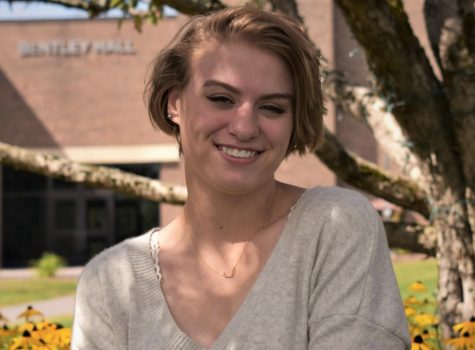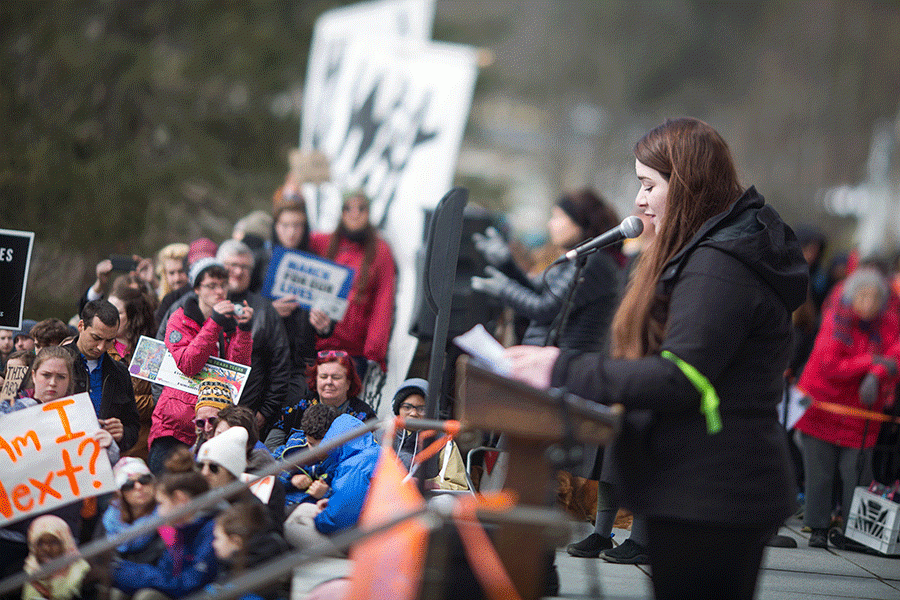Three JSC students spearhead March for Our Lives in Montpelier
JSC early college student Olivia Horton speaking at March for Our Lives in Montpelier
“Saying you’re working with March for Our Lives does not mean you’re antigun, and it does not mean that you are for taking away guns,” says Mackenzie Murdoch, a JSC student. “I’m not trying to take away guns, I’m just trying to regulate them and make places safer. This is not me hating guns, this is me hating gun violence.”
On Saturday, March 24, history was made. This history, however, wasn’t made by lawmakers, sitting within the confines of traditional structure and centuries of practice; it was made by a sea of young, passionate college students flooding from all over Vermont, gathered together on the front lawn of the State House on a clear, sunny spring day.
“I grew up 10 minutes away from Sandy Hook,” says Madison Knoop, a JSC student. She, along with collaborators Mackenzie Murdock and Olivia Horton, were the masterminds behind what was originally a small protest, which developed into a state-wide demonstration. “I was personally and truly affected by the mass shooting that took place there. Everyone knew people in the school and everyone knew everyone, so it was something that was very personal.”
Knoop had seen that the Parkland Youth — a group of students from a school that had also endured a mass shooting and who began the #neveragain trend — had been organizing the nation-wide “March for our lives” movement. Knoop noticed that Vermont didn’t have anything planned, so she took it upon herself to change that.
“I made a Facebook Event Page for it, and then I got in contact with a few organizations, and we got together and planned from there,” says Knoop. She became the MC for the event.
Murdoch, a close friend of Knoop and a first-year student at Johnson, recognized she needed help planning and decided to join. “Obviously, gun violence impacts students everywhere, and so I think that there’s just a consensus that, as a student, this impacts me,” says Murdoch. “Seeing the Parkland Youth — they are all very inspiring in what they do, and I think it would be hard to not take part in what they’re doing.”
Horton, another JSC student, decided to join after her two friends made her aware they were planning this endeavor. “I felt passionate about this,” said Horton. “I’m personally scared someone could just walk on JSC’s campus, because there’s not a lot of security at all.”
The three students, without the help of the college administration, organized a march that had between 2,500 to 3,000 people attend. A few legislators came to watch in support as well, including State Senator Allison Clarkson, State Senator Rebecca Baylin, House Representative Peter Welsh and Washington Senator Bernie Sanders.
“A lot of the Legislators in the Vermont State House have been working hard on gun legislation,” says Knoop. “They did come out and show their support, which was fantastic, and we gave them the recognition they deserved because so many of them have been working really, really hard on this issue.”
However, none of the legislators spoke that day. “I wrote an open letter to all legislators and all politicians, inviting them to this event and telling them that this is meant for you to come listen to, and respect, the youth,” says Murdoch, “but that this is not a place for politicians to speak. Politicians make their crowds, and this was our crowd we made.”
In this way, they were able to create a platform for all youth speakers to have their voices heard, uninterrupted.
As with any protest, there were many counterarguments thrown at the movement. One is that an AR-15 can be used as a hunting weapon. To that, Murdoch says, “There are guns made for hunting, and these weapons of mass destruction are not.”
Each student left the march with a vivid image of the impact they had made on such a large body of college students.
“I guess the most impactful moment for me was at the end of the event,” says Knoop. “I asked everyone to hold hands, and just made sure everyone knew this is something we could do in unity. And everyone did hold hands . . . This is something, as a group, we can get done.”
Horton added that the one NRA supporter who showed up to the event put down his sign to hold hands with the supporters as well.
“All of us were standing in a line on stage and looking out and seeing all of the people that were in support of what we were doing — [it] was incredible,” says Murdoch. “I think all of us knew that there was going to be a lot of people, and we had been hearing that 3,000 people was our estimate, but I don’t think we realized what 3,000 was until a bunch of people came up to us personally afterwards to thank us for our work.”
For Horton, seeing so many supporters in the same place put the situation in perspective. “It made me feel like we’re not alone. The majority of people in America do believe in passing some sort of law to mitigate issues like gun violence,” she says.
Horton also made a call for action speech. “I just told everyone what they could do after the march — the march is great. It’s incredible to have everyone come together to support our cause. But then it’s like, you go home back to your communities and say, ‘What do you do next?’” Horton encouraged protestors to get in touch with their legislators and have meaningful and respectful conversations with neighbors.
According to WCAX News, the Legislature is in the process of passing the S.55 Gun Bill, outlining new regulations on guns. This includes expanding background checks to encompass private sales, raising the gun purchasing age to 21 years old and banning high-capacity magazines.
“It’s a lot easier than you think to get involved,” says Knoop to any students thinking about joining. “It’s really easy to call your representative and say, ‘I support this.’ You can write the editor of your local newspaper showing your support of gun reform.”
For Horton, effective action begins with information and research by individuals.
“Make sure you’re not being misinformed,” says Horton. “I think that everyone should be doing their research on fatalities.”
Murdoch echoes the need for assuming responsibility, for becoming informed on issues and for voting intelligently. There is, she stresses, power in the ballot. “Also focus on who you’re voting for,” says Murdoch. “If you’re able to vote, make sure you’re registered to do that, and make sure you’re paying attention to who you want to be voting for.”

Senior, Journalism & Studio Art
Grew up in Craftsbury, VT
Spring 2018 - Present
I got a black eye and mild concussion in Las Vegas during a rugby...



